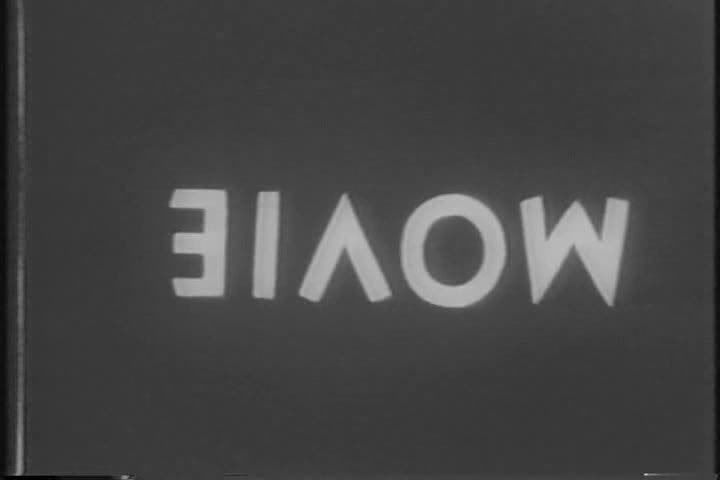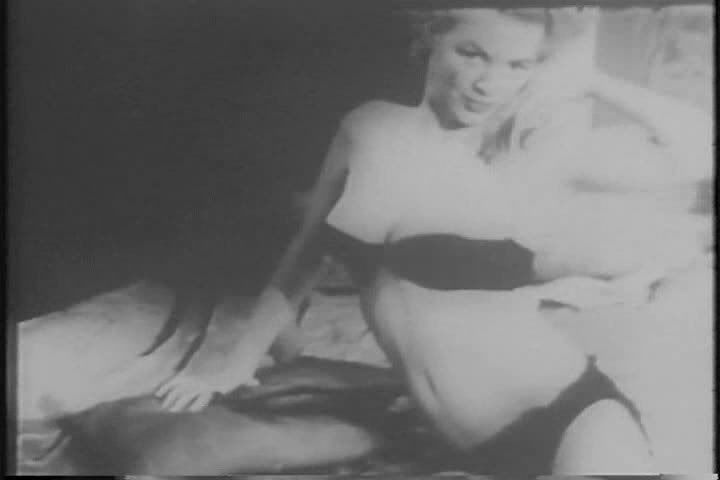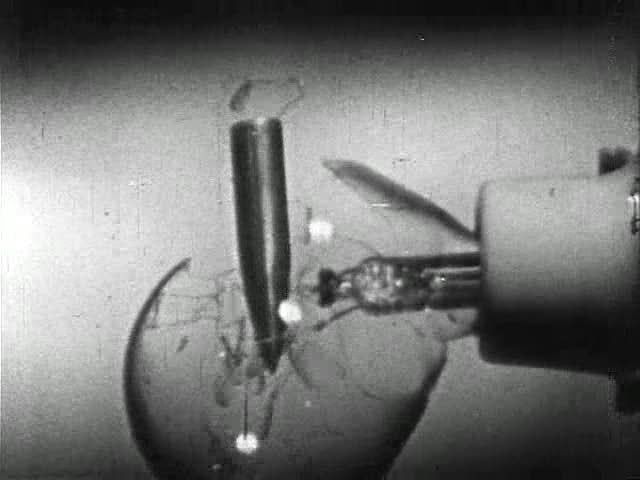
The singular title of Bruce Conner's A Movie positions this avant-garde short as though it were a prototypical example for the entire medium. In fact, Conner's film is the self-conscious inheritor of a particular tradition within the movies, a particular use to which moving pictures have been put: the filmic spectacle. Where Conner's film, constructed entirely from a wide variety of found footage, diverges from this tradition is in its recognition that in spectacle, the content hardly matters so much as the sensations conveyed through the film. Conner claims the cinema as essentially an art of montage, of combination, cutting together disparate materials from Hollywood epics, car and motorcycle races, plane and boat crashes, war footage, the atomic bomb, and sexy girls. It's like a catalog of the cinema's sensationalist devices, all of them blended together with little regard for their origins. A rapid-fire montage towards the beginning of the film switches almost seamlessly between horses in a cavalry charge, a trotting elephant, a train, and cars speeding around a track. The viewer has to strain to even notice the transitions, which happen almost subliminally because the scene's dominant feel is maintained across each fluid cut: it's speed, pure and simple, and the racing, speeding object hardly matters in comparison to the overall impression communicated by the montage. Conner is exposing the most basic workings of cinema here, intuitively grasping that he can cut together very different material and still achieve something that "feels" right because its editing has the proper rhythms.
Conner's movie also acts as a great leveler between various kinds of images: documentary versus staged, violent versus prosaic, frivolous versus serious. The film's general arc is towards more and more devastating images, even as the soundtrack becomes bombastic and stirring, its epic grandeur clashing against the images of starving children, dead soldiers, and the distinctive mushroom cloud of the atomic bomb. Conner can be playful too, especially in his use of familiar cinematic devices in ways that confound expectations: he keeps flashing up the words "the end" at various points, and initiates a countdown towards the start of the film that's interrupted by a striptease, as though he just couldn't wait until the count was over to get into the film itself. But his best visual gag leads directly into his most horrifying image, as a shot of a pinup girl posing in a tiny bikini cuts to a submarine crew firing a phallic torpedo which, in turn, improbably sets off a nuclear explosion. The Freudian playfulness of the imagery is basically cut short, reminding viewers that despite psychological speculation to the contrary, a weapon is less a sexual symbol than a tool of grand destruction. The puffy, blossoming explosion of a mushroom cloud may make a clever metaphor for an orgasm, but it's a metaphor with its own horrible realities attached.

Conner is constantly playing with these kinds of multiple layers, and he packs a great deal of potential meaning into barely 12 minutes. During the final minutes of the film, the editing grows more and more frantic as the music reaches its crescendo, signaling a typical movie climax that Conner will not deliver. His imagery, which had hitherto blended traditional spectacles and samples of Hollywood footage into the war movies and explosions, now delves wholeheartedly into the darker side of spectacle: firing squad executions, a field of dead bodies, a blimp imploding into a fiery ball that looks like the heart of a volcano. The music and the frantic editing condition the audience to expect excitement, but Conner challenges them to be excited by these abject images instead — he mocks the conventions of cinematic narrative by delivering a montage of horror in the guise of an action movie climax. The effect is bracing, as the aesthetic tensions between music, editing, and imagery reach a breaking point and then give way to an enigmatic, poetic coda of a diver descending into a mysterious porthole, disappearing with one last flip of the fin.
The film forces viewers to engage actively with its content, to question its effects and the cinematic tools it uses to achieve them. There is no other film this side of Godard in which the evidence of the filmmaking is displayed so nakedly, in which the role of montage and music in creating emotional responses are made so apparent. The continual pauses built into the editing, the stretches of black leader that divide one section from another, provide the necessary blank spots that shatter the illusions that Conner is simultaneously creating and deconstructing. The black spaces give the film a rhythm like breathing, or thinking, each chain of fluidly edited images eventually giving way to a black screen on which the individual viewer can trace his or her own thoughts.
One of the film's most enduring legacies may be the forceful way in which it lays claim to cinema as a medium defined by editing. Conner keeps asserting his authorship in titles that recur at odd points throughout the film: "A Movie by Bruce Conner," as though there were any doubt that the film belongs to him, despite the fact that he didn't shoot any of the footage he uses. It's a clever way to develop the idea that the artistry of movies lies, first and foremost, in the arrangement of images. The basic technique of A Movie is to expose and explore these kinds of fundamentals, to draw attention to the normally invisible artifice of movies by recreating that artifice with illogical combinations of elements.

Report is a fragmentary, harrowing attempt to come to terms with the circumstances of the Kennedy assassination, and especially, in light of the infamous Zapruder tape that captured the event, to understand what it means to document or report on an event like this. Bruce Conner's attempt at a "report" on Kennedy's death uses footage from Zapruder and from various other news outlets, along with radio voiceovers, but he does not combine these elements in a traditional, objective way. Conner's conception of a "report" is not the dry recitation of facts or the following of a strict chronology, but an analysis of the emotional impact and political ideas that circle around the central event. To this end, Conner methodically takes the day apart and dissects it, first documenting the assassination itself before both doubling back into the past and shifting forward into the future. This chronology privileges the intensity and epoch-changing nature of the actual event while acknowledging its place within a complex political and social spectrum that both led up to it and was forever altered by it.
Conner's account of the assassination is as unforgettable as any more traditional report, despite the complete absence of any exploitative footage actually showing the bullets hitting the president. This moment is emotionally occupied in the film by a now-famous shot of a bullet passing through a lightbulb, shattering its glass and passing through undeterred, a deeply affecting metaphor for the death of a political luminary. In the place of more graphic images, the film repeats a few seconds of grainy footage: the president's limo driving along, Jackie and John smiling and waving in the back, images and faces so iconic that even deprived of most of their detail they are instantly recognizable. In between brief flashes of these images, the film consists entirely of pure black frames, which separate the images with increasingly long times until the presidential limo disappears entirely, replaced by a pulsating flicker of alternating white and black frames, occasionally complicated by basic abstract designs within the black. As the screen pulses and flickers, the soundtrack features a news commentator who is reporting on the assassination live as it happens, his voice breaking into panic and confusion as the shots ring out and the motorcade grinds to a halt. No one is sure who has been hit, and the announcer's increasingly tense tone seems to stem as much from his confusion, his lack of knowledge about what's going on, as from any concrete event. Conner enhances this tension by chopping up the voiceover and looping it, doubling back to hear key phrases again, and towards the end distorting the announcer's voice and bathing it in static until it sounds like he's speaking from inside a blender.

If Conner's treatment of the assassination is uniquely moving and powerful, his way of handling the aftermath and lead-up to this epochal event is even more ingenious. The second half of this brief film blends together past and present by having the voiceover loop back to before the assassination, as the radio announcer describes in much calmer tones the route of the presidential motorcade, the role of the Secret Service in protecting him, and the president's possibly unsafe habit of stopping to shake hands with admirers. All this would seem like foreshadowing had Conner not already shown what happens next. Instead, the voiceover seems like a bulletin from a more innocent time, in which these words would not have had the same horrible prophetic ring they now do. The announcer's words acknowledge the possibility of danger, but almost in a quaint, dismissive way: the voiceover is mostly just impressed by Kennedy's friendliness and spontaneity, not genuinely fearful for what might result. Conner underscores this lost innocence by accompanying the voiceover with a complex montage of images, encompassing footage from Kennedy's funeral, various images from Kennedy's tenure as president, and even a wide variety of seemingly unrelated images ranging from bullfights to war films to refrigerator ads. This material positions Kennedy and his death within a broader social, political, and media context, perhaps suggesting that without a focus on the event itself and its repercussions, Kennedy risks becoming a mythic component in a media-saturated environment, his image juxtaposed without consideration with crass commercialism and unrelated political maneuverings — a prophetic message, as it turns out.

2 comments:
A Movie is above all a film about Death. The Atmoic bomb is seen as the end of the world as we know it, triggering to a return to the sea and the origins of life. It's cinematic precedent is Cornell's Rose Hobart. But Cornell's wit has little in common with Conner's, which looks forward to the songs of Randy Newman.
The title Report is a pun, as it evokes the "report" of a fired gun. It's darly hilarious -- especially in the sequence in which the rifle that killed Kennedy is juxtaposed with e new refrigerator.
where were you able to find the movie "Report" to watch it? I'm having a hard time despite it being listed as one of the "1001 movies I should see before I die".
Post a Comment